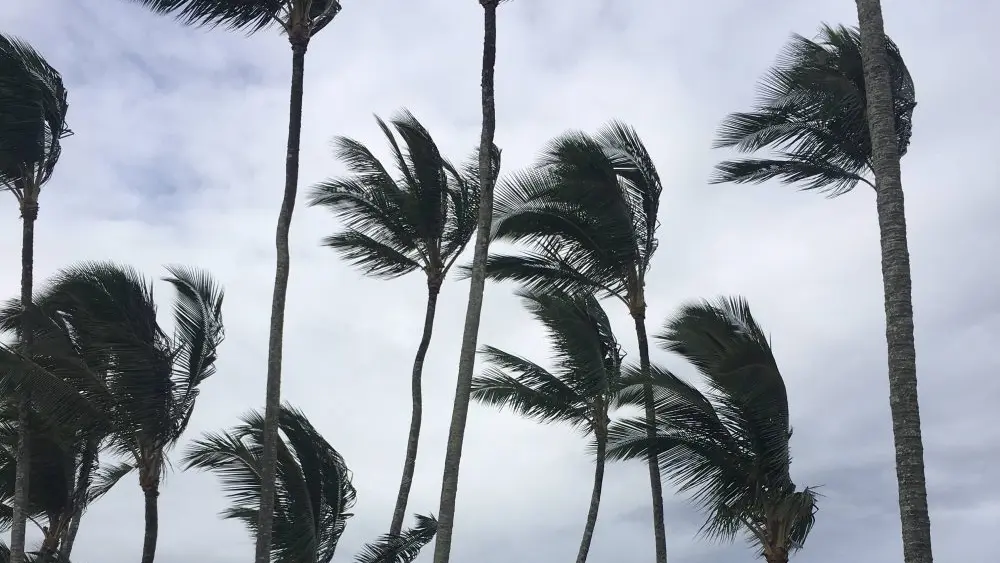Two beige water tanks blend into the dull gray blanket of highly flammable invasive grasses covering a property on the other side of Honoapiilani Highway from Māalaea Harbor.
The state Department of Land and Natural Resources recently installed a 30,000-gallon storage tank and 10,000-gallon helicopter dip tank in South Maui — the first of several to be placed around the island to improve firefighting capabilities, according to Lance DeSilva, the department’s forest management supervisor on Maui.
“We have fought fires there many times over the years,” DeSilva said about why the Māalaea location near the intersection of North Kīhei Road was chosen. “We are trying to install these dip tanks around Maui island and around Maui County in strategic places where we can aid the helicopters so that their initial attack can be much quicker.”
County and state employees are planning to put the tanks in 10 to 15 locations prone to wildfires or that lack accessible water sources so that helicopters responding to future wildfires will have access to water to attack flames from the air, he said. Nearly all of Maui is experiencing drought conditions.
“The whole point of these dip tanks is to reduce the amount of resources that you need for the helicopters to come in and grab water, and that can increase their effectiveness and reduce the time that it takes to get from the actual fire to the water source,” DeSilva said. “Because it’s precious time.”
Maui Fire Department Assistant Chief Alexander Parker said every minute counts when it comes to fighting wildfires.
“If that water source is already there in close proximity to the fire, the helicopter can start working right away,” he said. “A lot of times, the success or failure of an operation — when it comes to helicopters — is turnaround time.”
In the past, helicopters have collected water using a variety of reservoirs and ponds across the island and portable dip tanks called pumpkins that can be transported closer to fires by fire and tanker trucks, he said. Those tanks are smaller, holding 3,000 to 5,000 gallons.
In some cases, helicopters have also been able to get water from the ocean, but Parker said that can be logistically complicated because highways have to be closed before the helicopters can carry water over them.
There’s been no shortage of fires to fight on the Valley Isle of late. The Maui Fire Department responded to 555 blazes, including more than 200 forest and brush fires, between Jan. 1 and Sept. 30 this year, county data shows.
Citing New Tanks To Meet Greatest Need
The tanks are included in increased budgets for state and county firefighting efforts. On Maui, the county’s Department of Fire and Public Safety budget has risen more than $25 million since the Aug. 8, 2023 wildfires. The 2026 equipment budget, which calls for at least one tank, is $9.8 million — up more than fourfold from 2023.
County and state officials are working together to determine where the need is greatest, Parker said, where tanks can be easily connected to a local water supply and where they have access to the property.
Parker said county officials have mostly been focused on identifying where and how to install tanks in South Maui, while the DNLR Division of Forestry and Wildlife has been looking at locations in West Maui and in higher elevations.
Locations in Lahaina, Kīhei, Ukumehame, Olowalu and Launiupoko are among those that are being considered by officials, he said.
The tanks in Māalaea are fixed metal structures with a plastic liner, DeSilva said, and are expected to cost the state roughly $30,000 to $45,000. The price of future tanks, he said, could vary significantly based on factors, including how difficult the terrain is, the condition of existing infrastructure and what vendor is providing the tanks.
The county recently ordered its first 10,000-gallon rolling dip tank for about $18,000 from a company in Seattle that also manufactures many of the county’s roll-off dumpsters, Parker said.
“It’s kind of a trial run,” he said, adding that the plan is to eventually get three more. “Our thinking is that they’re mobile, and we can store them empty, and they’ll handle better than having a plastic liner. And if we get a big incident, we could theoretically deploy as many as we have to that area.”
More Efficient, More Effective
Some fire-conscious Maui residents welcomed plans to install helicopter dip tanks around the island. Gordon Firestein, the Firewise leader in Launiupoko, said any visible wildfire risk reduction efforts gave people in his community more peace of mind.
“There are lots of pieces to the wildfire response puzzle, so adding more — it all helps,” he said. “You never know which part of the puzzle is going to be the critical one that makes a difference.
Launiupoko has been an accredited Firewise USA community since 2016, when Firestein and his then-neighbor Linda Jenkins worked together to help their neighborhood earn the designation, awarded as part of a national initiative to educate residents on how to safeguard their neighborhoods against wildfires.
Jenkins is now a Firewise leader in Kahului’s Maui Lani neighborhood, where she said firefighters have had to take water from ponds at a nearby golf course to respond to fires in recent months.
“It would have been virtually impossible for the firemen to get in there if we didn’t have access to that water, so I think that in the places where you don’t have that really valuable water, it’s super important,” she said. “It’s going to be much more efficient, and therefore more effective.”
While the new, larger tanks will certainly aid firefighting efforts, Parker said, Maui’s fire department is already well prepared to respond to wildfires.
“We have a very robust portable tank inventory,” he said. “And we’re still going to use that. The new dip tanks are just going to be in conjunction to that.”
Story originally published by Honolulu Civil Beat and distributed through a partnership with The Associated Press.





